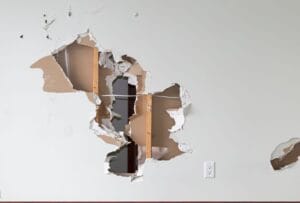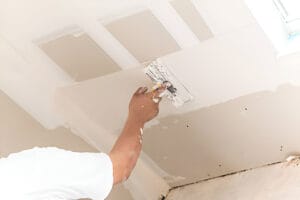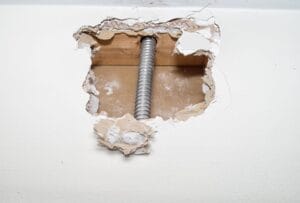Drywall Repair Large Holes- It happens, sometimes leaving you with a big hole in your Drywall. Depending on what caused the hole – moving furniture does this a lot, and so does a doorknob hitting a wall and plumbing repairs – mending a big hole in Drywall looks like a formidable task. Here’s a step-by-step approach to get you back to wall restoration like a pro.
TOOLS AND MATERIALS YOU’LL NEED
Before you begin, here are the tools and materials you will need:
- Drywall patch or drywall sheet (for large holes)
- Utility knife
- Drywall saw, or keyhole saw
- Measuring tape
- Pencil
- Support strips (1×2 boards or plywood)
- Drywall screws
- Drill or screwdriver
- Joint compound (mud)
- Putty knife (4-inch, and 6-inch)
- Drywall tape (mesh or paper)
- Sandpaper (120- to 220-grit)
- Primer and paint
Step 1: Prepare the Hole
Begin by clearing the ornate edges of the cavity. Cut Using a utility knife, or Drywall saw, cut a clean square or rectangular opening around the damaged area. This will make it easier to fit a replacement patch.
Step 2: Install Support Behind The Drywall
Indeed, for holes above 6 inches, you need strips of wood behind the Drywall to support the patch.
- Then, cut a piece of 1×2 wood a few inches longer than the hole.
- Slide it behind the DrywallDrywall and screw it into place with drywall screws and make sure that the support is secured solid.
- You can go as many times as you need to get that affirmation.
STEP 3: Cut and attach the drywall patch
- Measure the hole and cut the new Drywall to size.
- Position the drywall patch over the opening and attach it with drywall screws to the wooden supports.
- Make sure your screws are slightly recessed so that there are no bumps in the Drywall.
Step 4: Apply Drywall Tape
To avoid cracks in the repair, cover the seams of the patch with drywall tape. For stronger adherence or an easier installation, use paper tape or mesh tape.
Step 5: Apply Joint Compound
- Using a putty knife, apply a thin layer of joint compound over the tape.
- Allow it to dry thoroughly (about 24 hours), and then add a second and third coat, feathering out the edges for an even transition.
- Let each layer dry before moving on to the next.
Step 6: Sand the Surface
After the final coat is dry, take fine-grit sandpaper (120-220 grit) and sand down the surface. Do not be too harsh so that the patch does not get damaged.
Step 7: Prime and Paint
- Use a primer to seal the repaired area so the paint doesn’t absorb unevenly.
- When the Primer is dry, paint the wall a color that matches the surrounding area for a perfect, seamless finish.
Get You Started With Your Perfect Repair
- Apply joint compound in fragile layers – and layer, continue applying in delicate layers, bump-free.
- If you use mesh tape, I like to put it down and then put the first layer of joint compound over it.
- Lightly sand between coats for a smoother finish.
- If you can’t match the paint, it may be easier (and much cheaper) to paint the entire wall to create a cohesive appearance.
By following these steps, you can successfully Drywall Repair Large Holes and restore your walls’ appearance without needing professional help. With patience and the right materials, your wall will be as good as new.










